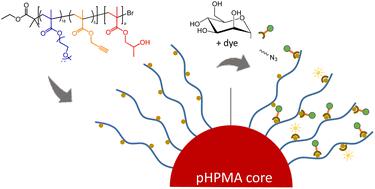当前位置:
X-MOL 学术
›
Polym. Chem.
›
论文详情
Our official English website, www.x-mol.net, welcomes your feedback! (Note: you will need to create a separate account there.)
Surface mannosylation of dispersion polymerisation derived nanoparticles by copper mediated click chemistry
Polymer Chemistry ( IF 4.6 ) Pub Date : 2024-02-09 , DOI: 10.1039/d3py01361h Daniela V. Tomasino 1 , Ashfaq Ahmad 2 , Tauseef Ahmad 3 , Golestan Salimbeigi 3 , Jennifer Dowling 3 , Mark Lemoine 3, 4 , Ruth M. Ferrando 5 , Alan Hibbitts 3, 4 , Ruairí P. Branningan 6 , Mathew I. Gibson 2, 7 , Luigi Lay 5 , Andreas Heise 1, 4, 8
Polymer Chemistry ( IF 4.6 ) Pub Date : 2024-02-09 , DOI: 10.1039/d3py01361h Daniela V. Tomasino 1 , Ashfaq Ahmad 2 , Tauseef Ahmad 3 , Golestan Salimbeigi 3 , Jennifer Dowling 3 , Mark Lemoine 3, 4 , Ruth M. Ferrando 5 , Alan Hibbitts 3, 4 , Ruairí P. Branningan 6 , Mathew I. Gibson 2, 7 , Luigi Lay 5 , Andreas Heise 1, 4, 8
Affiliation

|
The synthesis of spherical polymeric nanoparticles containing alkyne surface functionalities for post polymerisation glycosylation is described. The nanoparticles were obtained by a polymerisation induced self-assembly (PISA) inspired methodology in dispersed media by Cu(0) mediated polymerisation. A water soluble poly(ethylene glycol methacrylate-stat-propargyl methacrylate), poly(PEGMA18-stat-PgMA5), macroinitiator was first synthesised and chain extended with 2-hydroxypropyl methacrylate (HPMA) in water using a copper wire catalyst. It was found that irrespective of the macroinitiator to HPMA ratio and the reaction time the desired spherical morphologies (<100 nm) were obtained while the absence other morphologies suggest a deviation from the classical PISA process due to chain termination in the nanoparticle's core. The obtained nanoparticles contained alkyne functionalities in the shell, which were successfully reacted by copper mediated click chemistry with fluoresceine azide and mannosides with hydrophobic and hydrophilic spacers of different lengths. The obtained mannosylated nanoparticles displayed no significant cytotoxicity against human alveolar basal epithelial adenocarcinomic (A549) cells at any dose <0.5 mg mL−1. Preliminary binding studies confirm the ability of the mannosylated nanoparticles to bind to human lectin dendritic cell-specific intercellular adhesion molecule-3-grabbing non-integrin (DC-SIGN). The methodology reported here is a convenient route to well-defined spherical and shell-functionalisable nanoparticles to create libraries of bio-active nanomaterials.
中文翻译:

通过铜介导的点击化学对分散聚合衍生的纳米颗粒进行表面甘露糖基化
描述了用于后聚合糖基化的含有炔表面官能团的球形聚合物纳米粒子的合成。纳米颗粒是通过聚合诱导自组装 (PISA) 启发的方法在分散介质中通过 Cu(0) 介导的聚合获得的。首先合成了水溶性聚(甲基丙烯酸乙二醇酯-静态-甲基丙烯酸丙炔酯)、聚(PEGMA 18-静态-PgMA 5 )大分子引发剂,并使用铜线催化剂在水中用甲基丙烯酸2-羟丙酯(HPMA)进行扩链。结果发现,无论大分子引发剂与 HPMA 的比例和反应时间如何,都可以获得所需的球形形态(<100 nm),而缺乏其他形态表明由于纳米颗粒核心的链终止而与经典的 PISA 过程存在偏差。获得的纳米颗粒在壳中含有炔烃官能团,通过铜介导的点击化学成功地与具有不同长度的疏水性和亲水性间隔基的叠氮化荧光素和甘露糖苷发生反应。所获得的甘露糖化纳米颗粒在<0.5 mg mL -1的任何剂量下均未表现出针对人肺泡基底上皮腺癌(A549)细胞的显着细胞毒性。初步结合研究证实了甘露糖化纳米颗粒与人凝集素树突状细胞特异性细胞间粘附分子-3-抓取非整合素(DC-SIGN)结合的能力。这里报道的方法是一种便捷的途径,可以得到明确的球形和壳功能化纳米粒子,以创建生物活性纳米材料库。
更新日期:2024-02-14
中文翻译:

通过铜介导的点击化学对分散聚合衍生的纳米颗粒进行表面甘露糖基化
描述了用于后聚合糖基化的含有炔表面官能团的球形聚合物纳米粒子的合成。纳米颗粒是通过聚合诱导自组装 (PISA) 启发的方法在分散介质中通过 Cu(0) 介导的聚合获得的。首先合成了水溶性聚(甲基丙烯酸乙二醇酯-静态-甲基丙烯酸丙炔酯)、聚(PEGMA 18-静态-PgMA 5 )大分子引发剂,并使用铜线催化剂在水中用甲基丙烯酸2-羟丙酯(HPMA)进行扩链。结果发现,无论大分子引发剂与 HPMA 的比例和反应时间如何,都可以获得所需的球形形态(<100 nm),而缺乏其他形态表明由于纳米颗粒核心的链终止而与经典的 PISA 过程存在偏差。获得的纳米颗粒在壳中含有炔烃官能团,通过铜介导的点击化学成功地与具有不同长度的疏水性和亲水性间隔基的叠氮化荧光素和甘露糖苷发生反应。所获得的甘露糖化纳米颗粒在<0.5 mg mL -1的任何剂量下均未表现出针对人肺泡基底上皮腺癌(A549)细胞的显着细胞毒性。初步结合研究证实了甘露糖化纳米颗粒与人凝集素树突状细胞特异性细胞间粘附分子-3-抓取非整合素(DC-SIGN)结合的能力。这里报道的方法是一种便捷的途径,可以得到明确的球形和壳功能化纳米粒子,以创建生物活性纳米材料库。



























 京公网安备 11010802027423号
京公网安备 11010802027423号